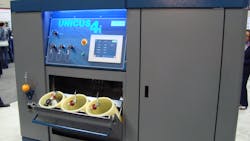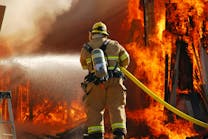Microprocessors Provide the Fire Service with the Ultimate 'Muscle Memory'
Microprocessors, or mini computers, are controlling the world these days and they’re controlling equipment in the fire service more and more as each day goes by.
I was at the trade show this spring and I was struck by the number of items that are now automated and rely on microprocessors to operate. It shouldn’t have been that surprising given the amount of computerization and automation that has infiltrated the rest of our lives.
Most of our phones these days have more technology and computer power than they had when the Apollo space launches occurred and can probably manage a Fortune 500 company with no trouble.
But, as the old adage goes, the fire service represents 200 years of tradition unimpeded by progress. It just took a little longer for it to hit the fire service, but it’s now full speed ahead with automation.
That’s not a bad thing.
In fact, in many cases it’s a very good thing.
Muscle memory is something firefighters know a lot about and it’s supposed to be achieved by constant training. It becomes automatic so when stuff hits the fan, we all know what we’re supposed to do without too much thinking.
So, think of the microprocessor as that “muscle memory.” We “teach” the technology what we want it to do and when we want to do it and manufacturers make sure the equipment they make for us will do it. It’s a reasonably simple process and one we are coming to rely more on as technology progresses.
Aerials these days will not rotate over the short-jacked side of the rig if there’s a danger of it tipping over or becoming unstable. That’s done by microprocessors that measure parameters and stop operations if they become dangerous. At o-dark-thirty hours, that’s a good thing when our minds and our muscle memory might be a little foggy from sleep deprivation.
It might be a little like big brother watching out, but I’m OK with that. Besides, from everything I know, there are overrides that let humans make the ultimate decision. So, if a firefighter, or officer, decided to operate a little outside the envelope, which is very conservative, to make a heroic rescue, they can make the decision to do just that. It goes back to another old adage – risk a lot to save a lot, risk a little to save a little… and you know the rest.
One of the most interesting things I saw at the show was a fully automated SCBA bottle refill system developed by Bauer Compressor. Called the UNICUS 4i, it was the first fill station I’ve ever seen that has a touch screen and, if the bottle had an RFID “chip”-like device to it, the system would automatically record that refill, keep track of its hydro testing and any other information, like how many fills and who did it and when. It would be stored in its own computer for the user to retrieve as needed. It even “writes” the information back on to the bottle for future reference. It’s pretty slick.
The unit also had a way to do air quality sampling and send information out for third-party analysis. For me, it was like the Jetsons had come up with a way to refill SCBA bottles efficiently and safely.
At my station, we have an older refilling station with DOT air bottles arranged for cascade refilling. Every firefighter that’s ever refilled a bottle knows it can be challenging to know which bottles to open and when to get the maximum pressure into the tanks.
One of my firefighters recently filled bottles after a training exercise and got them just barely into the green. I sent them back for “topping off.” In some cases, that minute or two can make the difference between life and death. I think he got the message and did it.
A machine is not programmed to do things just good enough or, in most cases, use judgement to make decisions, not yet anyway.
Other interesting things involving computers and high tech were a couple of things on a Spartan cab and chassis. Spartan developed a way to make the cab of their apparatus be a wifi hot spot that takes advantage of available networks in the area and makes them available for emergency use. It’s a great way to access the Internet to get valuable information, particularly hazmat situations. It can also make incident command easier with stronger, more viable communications available for communicating with the outside world.
Spartan also had a new “intelligent” back up camera that is able to read, interpret and display digital data to detect objects and movement, alerting the driver to hazards.
Darley is now using a radio frequency control to start and operate portable pumps. The company said it originally thought it would be used in the field, but they’ve found another application and that’s to start the pumps while they are still on the truck. Apparently, the radio frequency works more reliably then the hard wired controls.
Go figure.
Those are just a tiny fraction of the number of microprocessors that have infiltrated the fire service.
I have always thought humans have the capacity to figure out just about anything. Microprocessors and computers have long been a part of our lives, improving them in ways too numerous to mention.
Now, it’s time for them to move into the fire service – a little late to the party, but they’re here nevertheless.
And we’re better off for it.






